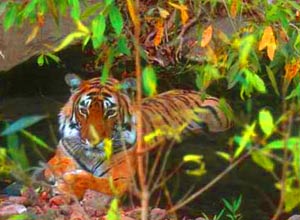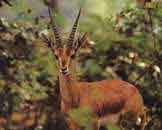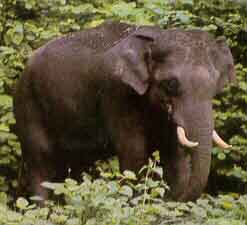| Environment The Wilderness
|
|||||
The tigress lay smack in the middle of the jungle road 30 metres ahead of our jeep, unafraid, staring as us with alert, gleaming eyes. To our left, a sambar bellowed in alarm. Above us a troop of langurs leapt nervously from branch to branch, barking gruffly. As we inched our jeep closer, she stepped off the road to watch us from under a tree. What a splendid picture she made, her glossy coat shining in the sunlight as it filtered through the branches. For nearly 20 minutes we watched her silently as she stretched and lazed. Occasionally she would lick herself clean like a domestic cat. Though we never saw them, she probably had her cubs around, for she soon got impatient and we realised we were no longer welcome. Her ears flattened and she glanced about anxiously. Having apparently decided that it was time for us to leave, she escorted us out in a very straightforward manner, by walking purposefully towards our jeep. Every few steps she would stop to check on us and when she was less than five metres away we slowly drove off with her padding along behind us to make sure we were really going. Then she vanished into the jungle. |
Environment • Beautiful Beasts • Paradise in the Wild • The Ocean:Conquest • A Source of Solace • Sighting the Ocean • The Ocean in Verse • Childhood Dream • Hunt for Indian Tiger
Adventure activities | ||||
For most travelers, a three or four day trip is the norm. The days pass all too quickly and the drives in the jungle are packed with opportunities for bird-watching and spotting animals. Afternoons are best spent exploring historical sites such as the battle-scarred Ranthambhor Fort, which is reputed never to have been conquered. Night-time in the jungle has a charm of its own and I often sit watching the reflection of stars in the still waters of one of the many lakes that dot India's wild places. A four-hour Frontier Mail train ride from Sawai Madhopur towards Delhi takes you to Bharatpur. Here the short five km. journey to the swamps of Keoladeo Ghana is best made on a horse-drawn tonga which clip-clops its way through the dusty town. Nothing can prepare you for the contrast as you enter the confines of the verdant preserve created by the Maharaja of Bharatpur at the turn of the century to attract migratory birds, which he and his guests would proceed to shoot in the thousands. Cycles and cycle rickshaws provide a noiseless, fun way to move about the sanctuary. Bird-watchers confirm having seen more birds here in the one day than they have in a year of serious bird-watching in most areas. Apart from the famous Siberian cranes which ornithologists travel halfway around the world to see in winter, one can spot cormorants, snakebirds, kingfishers, fishing eagles, harriers, storks, moorhens, pelicans and any number of waders. No one who visits Bharatpur can remain unmoved by the magnificent sight of its heronries, or the apparent ease with which hundreds of thousands of birds manage to live in such close proximity.
For sheer diversity it would be difficult to come by a country with more to offer than India. Rainforests, swamps, leafy glades, scrub, desert and snow-capped mountains; all are accessible to those who care to venture out. I have journeyed for two long decades to every conceivable Indian wilderness and have still not experienced even a fraction of the natural bounty we are fortunate to possess. Himalayan havens in Kashmir, Ladakh, Garhwal, Himachal, Assam and Arunachal Pradesh are all dotted with sanctuaries and national parks of indescribable beauty. Here black bear, pheasants, deer and carnivores cling on to a fragile existence in a world decorated by orchids and towering peaks. Visiting such areas is relatively easy, provided one does not expect five-star luxuries. Naturally it is best to make arrangements in advance but almost everywhere, the traditional hospitality of the Indian people ensures a hot meal, a friendly welcome and a place to rest a tired body for the night. All you need to pack is humility, essential trust and low- key demands along with a good pair of walking boots and a sleeping bag.
The north-east of India which extends east of Rangoon in places, is a world of creepers, lianas, ferns and ever-damp forests. Namdapha in Arunachal, for instance, boasts of four major cat predators -- the tiger, leopard, clouded leopard and that grey ghost of the Himalaya, the snow leopard. In Kaziranga and Manas in Assam, visitors can still see one-horned rhinos, elephants and wild buffalo as they fight for survival in an area commandeered by poachers, insurgents and misguided businessmen intent on converting these priceless forests into cash. The Sundarbans in West Bengal harbours the greatest concentration of mangrove forests, and tigers, in the world. Here in the tangle of mangrove roots a unique mid-world between sea and land can be observed from boats which glide through muddy estuaries. Reptiles, including the salt-water crocodile and mudskippers -- fish that climb trees -- are among the many wonders of this remote paradise. For a taste of Kipling country, visit Madhya Pradesh. Kanha and Bandhavgarh provide among the finest wildlife experiences available on earth. In Kanha, the hardground barasingha, have been saved from the jaws of extinction, thanks to the protection afforded to the forest by Project Tiger. In Kanha I have seen a tigress suckle her month-old cubs, watched a cobra slither up a tree in pursuit of a warbler and looked on as wild dogs cornered a chital hind in full view of her herd. These jungle dramas are a daily occurrence and provide long hours of fascinating viewing for the patient and persistent visitor. But all these sights are indeed a mere bonus. Just being out in the open in the lap of nature is reason enough to visit these beautiful wild places, whose very future is threatened by rampant destruction for short-term commercial gains.
Sitting in a hide in a remote part of Nagarhole, I watch elephants gambol like oversized babies in a cool water-hole. Oblivious of the threats to their existence from the ambitions of man, these prehistoric giants play out their destinies, programmed by instincts genetically passed down from parent to calf over millions of years. As with other species, elephant populations are dwindling due to poaching and habitat destruction. The forests of our country are under siege. Wildlife tourism is one of the finest ways to spread both appreciation and concern for nature among our people, but am truly concerned that such tourism threatens to become the preserve of the rich, leaving ordinary people either apathetic, or alienated. As anyone who visits our sanctuaries will confirm, foreigners have already discovered the delights of wild India. And it is a shame that more Indians do not take the trouble to visit these natural havens, for there is no better way to fall in love with your country than to visit its wilds.
Courtesy: Sanctuary Magazine
|
|||||
Editor: Romola Butalia (c) India Travelogue. All rights reserved. |
|||||
 Ranthambhor in Rajasthan is one of India's finest tiger reserves. As the train pulls into the dusty Sawai Madhopur station, Shafi Mohammad, naturalist-driver-tour operator and trusted friend, greets visitors with a broad smile. A mere 30-minute jeep ride from the station and you are in the very heart of the forest, lunching under the boughs of a venerable banyan tree which actually finds mention in the Akbarnama.
Ranthambhor in Rajasthan is one of India's finest tiger reserves. As the train pulls into the dusty Sawai Madhopur station, Shafi Mohammad, naturalist-driver-tour operator and trusted friend, greets visitors with a broad smile. A mere 30-minute jeep ride from the station and you are in the very heart of the forest, lunching under the boughs of a venerable banyan tree which actually finds mention in the Akbarnama.

 There are an incredible number of sanctuaries and parks awaiting tourists in Rajasthan. Sariska, near Alwar is yet another sanctuary which boasts over 30 tigers and innumerable other carnivores. Further west, is the Desert National Park near Jaisalmer. Great Indian bustards, houbara and sandgrouse can be spotted at water-holes and a host of other wildlife such as chinkara, blackbuck and nilgai can be seen from the roadside. Lesser known jungles such as Kumbalgarh, near Udaipur, one of the few places where it is possible now to spot the Indian grey wolf, also await discovery by the intrepid traveller in search of a holiday with a difference.
There are an incredible number of sanctuaries and parks awaiting tourists in Rajasthan. Sariska, near Alwar is yet another sanctuary which boasts over 30 tigers and innumerable other carnivores. Further west, is the Desert National Park near Jaisalmer. Great Indian bustards, houbara and sandgrouse can be spotted at water-holes and a host of other wildlife such as chinkara, blackbuck and nilgai can be seen from the roadside. Lesser known jungles such as Kumbalgarh, near Udaipur, one of the few places where it is possible now to spot the Indian grey wolf, also await discovery by the intrepid traveller in search of a holiday with a difference.
 At the foot-hills of the Himalayas are located sanctuaries such as Dudhwa and Corbett -- the land of roar and trumpet. Such forests provide us with a glimpse of prehistory. Undisturbed for eons, nature manages the grasslands, glades and watercourses in the virgin wilderness with magnificent efficiency. Trees fruit in sequence, so that animals never want for food. Water is abundant, even when sources outside the forest dry up, underlining the intricate connection between natural vegetation and the water-cycle. Every moment, insects conspire to plant still more trees and monkeys, squirrels and rodents scurry about carrying seeds to the far corners of the jungle. Fish, crocodiles and turtles keep the lakes and rivers scrupulously clean.
At the foot-hills of the Himalayas are located sanctuaries such as Dudhwa and Corbett -- the land of roar and trumpet. Such forests provide us with a glimpse of prehistory. Undisturbed for eons, nature manages the grasslands, glades and watercourses in the virgin wilderness with magnificent efficiency. Trees fruit in sequence, so that animals never want for food. Water is abundant, even when sources outside the forest dry up, underlining the intricate connection between natural vegetation and the water-cycle. Every moment, insects conspire to plant still more trees and monkeys, squirrels and rodents scurry about carrying seeds to the far corners of the jungle. Fish, crocodiles and turtles keep the lakes and rivers scrupulously clean.
 Below the Godavari, the character of the Indian jungle changes subtly. In Karnataka, forests such as Nagarhole and Bandipur, where grey jungle fowl announce the start of each day, are well known and well visited. Here teak virtually replaces sal as the prominent tree. In summer when leaves are shed, the forest floor is particularly vulnerable to fire and carelessness on the part of tourists can be very dangerous. Tamil Nadu possesses some of the least discovered wildlife destinations in India. The Ananmalais, Kalakad, Mundanthurai, the Nilgiri Tahr sanctuary and Point Calimere can provide unending delight and a variety of experiences to nature enthusiasts. Here it is possible to see the lion tailed macaques, tahr, tigers, leopards, elephants and a bewildering variety of bird life, provided you go prepared, in the suitable season and with proper guidance.
Below the Godavari, the character of the Indian jungle changes subtly. In Karnataka, forests such as Nagarhole and Bandipur, where grey jungle fowl announce the start of each day, are well known and well visited. Here teak virtually replaces sal as the prominent tree. In summer when leaves are shed, the forest floor is particularly vulnerable to fire and carelessness on the part of tourists can be very dangerous. Tamil Nadu possesses some of the least discovered wildlife destinations in India. The Ananmalais, Kalakad, Mundanthurai, the Nilgiri Tahr sanctuary and Point Calimere can provide unending delight and a variety of experiences to nature enthusiasts. Here it is possible to see the lion tailed macaques, tahr, tigers, leopards, elephants and a bewildering variety of bird life, provided you go prepared, in the suitable season and with proper guidance.